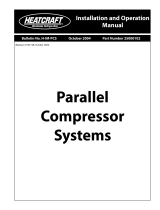Page is loading ...

Moisture & Liquid Indicator
Installation Instructions
GENERAL - The YELLOW JACKET
Moisture and Liquid Indicator may be
installed anywhere in the liquid line.
When located between the filter-drier
and the expansion device, bubbles
indicate a shortage of refrigerant or a
restriction in the liquid line such as a
plugged drier. Change the drier when
the color is in the caution or wet
range. When received, the indicator
may not indicate dry. This in no way
affects operation or calibration of the
indicator. The action of the indicator
element is completely reversible and
will change color whenever the
moisture content of the system
changes.
The indicating element may change
color rapidly on some installations, while
others may take a much longer period of
time. New systems or systems where
the drier has been replaced will cause
the indicator to start changing color
almost immediately. However, it is
recommended that the equipment
operate for 12 hours to allow the
system to reach equilibrium before
deciding if the drier should be changed.
The drying of the system should be
continued until the indicating element
stays dark green.
The moisture change level of the refrig-
erant in the Parts Per Million (PPM) for
the various YELLOW JACKET Moisture
and Liquid Indicator colors is shown in
the chart below.
Indicator
Shows
Refrigerant
11 & 12 123 & 22 134a 113, 114 & 502 404A & 507 410A
Liquid Line Temperature (°F)
75° 100° 75° 100° 75° 100° 75° 100° 75° 100° 75° 75°
Green
DRY
Below
5
Below
10
Below
30
Below
45
Below
50
Below
80
Below
10
Below
20
Below
15
Below
30
Below
120
Below
75
Chartreuse
CAUTION
5-15 10-30 30-90 45-130 50-200 80-225 10-45 20-65 15-90 30-140 120-
180
75-150
Yellow
WET
Above
15
Above
30
Above
90
Above
130
Above
200
Above
225
Above
45
Above
65
Above
90
Above
140
Above
280
Above
150
Moisture Content PPM
For use on refrigeration and/or air conditioning systems only.

Flaring Technique:
1. Deburr tubing before flaring.
2. Use a drop of oil on the cone of the
flaring tool.
3. Place drops of refrigerant oil on the
front and back surface of the flare
before drawing the nut tight. This
allows flare and fitting to mate
smoothly.
4. It is especially important to use
oil on joints where both the male
and female fittings are plated
steel. The oil will prevent galling.
Application Suggestions:
The YELLOW JACKET Moisture and
Liquid Indicator should not be used on
systems containing methyl alcohol or
similar liquid dehydrating agents unless
and oversize filter-drier has been
installed previously to remove these
additives. Certain colored liquid leak
detectors in a system may permanently
discolor the moisture indicating
element.
On systems containing an excessive
amount of water, as a result of a broken
condenser or water chiller, do not install
the YELLOW JACKET Moisture and
Liquid Indicator until the filter drier or
the replaceable cores have been
changed several times to reduce the
initial high moisture content. Liquid
water will dissolve and wash away the
color indicator material resulting in a
light yellow or white color. This type of
damage is permanent - the YELLOW
JACKET Moisture and Liquid Indicator
will no longer change color. If the
indicator paper is damaged, it is prefer-
able to change the YELLOW JACKET
Moisture and Liquid Indicator .
Bypass Installation:
The YELLOW JACKET Moisture and
Liquid Indicator may be installed in a
bypass to the main liquid line when
desired - and must be installed in this
manner on lines larger than 2-1/8" O.D.
Bypass Installation Kits:
While satisfactory liquid and moisture
indication will generally be obtained in
any position, preferred methods of in-
stallation are shown in Figures A and B.
The YELLOW JACKET Moisture and
Liquid Indicator is suitable for use with
halocarbon refrigerants, including R-11,
12, 22, 113, 114, 134a, 404A, 407C,
410A, 502 and 507. Listed by Under-
writer's Laboratories, Inc. for a working
pressure of 650 psig or 4482 kPa.
YELLOW JACKET Products Division
10950 Hampshire Avenue South
Bloomington, MN 55438 USA
Phone: 952-943-1333
Phone: 800-769-8370
Fax: 952-943-1140
e-mail: [email protected]
Web Site: www.yellowjacket.com
Printed in U.S.A. Part #500182
/




